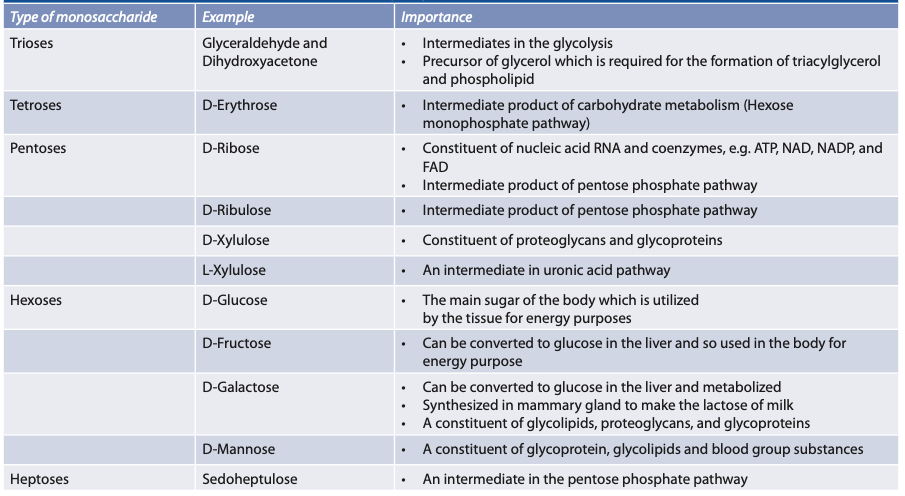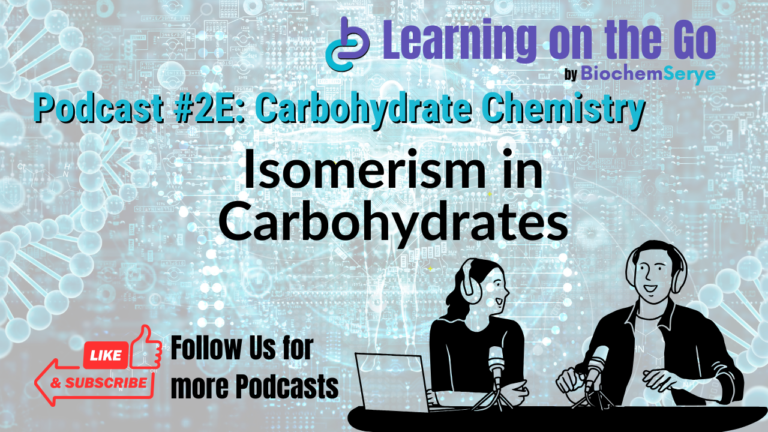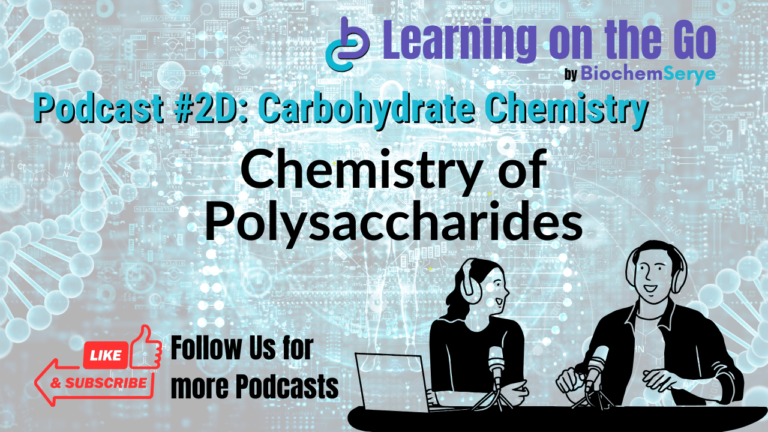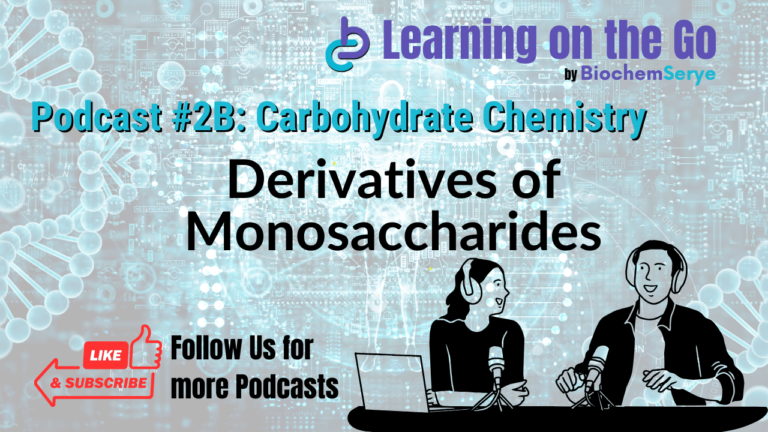Chemistry of Carbohydrates Biochemistry Notes
Chemistry of Carbohydrates Biochemistry Notes Outline
I. Chemistry of Carbohydrates Introduction and General Concepts
- Definition: Carbohydrates are chemically defined as aldehyde or ketone derivatives of polyhydroxy alcohols or substances that yield these derivatives upon hydrolysis.
- Basic Composition: They primarily consist of carbon, hydrogen, and oxygen, often following the empirical formula [CH2O]n, although exceptions exist.
- Nomenclature: Also known as “saccharides,” derived from the Greek word “saccharon” meaning sugar.
- Functions:
- Energy Source: Primarily serve as a source of energy (e.g., glucose). Source of energy for living beings, e.g., glucose
- Energy Storage: Store energy in forms like glycogen (animals) and starch (plants). Storage form of energy, e.g., glycogen in animal tissue and starch in plants
- Structural Components: Build structural elements like cellulose (plants), chitin (insects) and glycosaminoglycans (humans). Serve as a structural component, e.g., glycosaminoglycans in humans, cellulose in plants, and chitin in insects.
- Dietary Fiber: Non-digestible carbohydrates like cellulose serve as dietary fiber.
- Nucleic Acid Component: Form the sugar components of RNA (ribose) and DNA (deoxyribose). Constituent of nucleic acids RNA and DNA, e.g. ribose and deoxyribose sugar
- Cellular Roles: Play roles in lubrication, cell communication, and immunity.
- Detoxification: Involved in detoxification processes (e.g., glucuronic acid). Carbohydrates are also involved in detoxification, e.g. glucuronic acid.
II. Chemistry of Carbohydrates: Classification
- Monosaccharides (Simple Sugars): Single polyhydroxy aldehyde or ketone units; cannot be hydrolyzed further.
- Subdivided based on carbon number (trioses, tetroses, pentoses, hexoses, heptoses) and functional group (aldoses and ketoses).
- Examples of important monosaccharides include glucose, fructose, ribose, and deoxyribose.
- The most abundant monosaccharide in nature is six-carbon sugar D-glucose.
- The table below lists biologically important monosaccharides with examples such as Glyceraldehyde and Dihydroxyacetone (intermediates in glycolysis), D-Ribose (a constituent of RNA and coenzymes), D-Glucose (main sugar used for energy), etc.

Biologically important monosaccharides. From Essentials of Biochemistry, 3rd edition.
- Oligosaccharides: Short chains of 2-10 monosaccharide units linked by glycosidic bonds.
- Disaccharides are the most abundant; examples include maltose, lactose, and sucrose (See table below).
- Oligosaccharides consist of a short chain of monosaccharide units (2 to 10 units) joined together by a characteristic bond called glycosidic bond, which, on hydrolysis, gives two to ten molecules of simple sugar (monosaccharide) units.

Classification of oligosaccharides and their examples. From Essentials of Biochemistry, 3rd edition.
- Polysaccharides (Glycans): Polymers of hundreds or thousands of monosaccharide units. High molecular weight, sparingly soluble in water, and not sweet. It can be linear (e.g., cellulose) or branched (e.g., glycogen).
- Two Types:
- Homopolysaccharides (Homoglycans): Contain only one type of monosaccharide (e.g., starch, glycogen, cellulose). When a polysaccharide is made up of several units of one and the same type of monosaccharide unit, it is called homopolysaccharide.
- Heteropolysaccharides (Heteroglycans): Contain two or more types of monosaccharides or their derivatives (e.g., glycosaminoglycans like heparin and hyaluronic acid). They contain two or more different types of monosaccharide units or their derivatives.

III. Chemistry of Carbohydrates: Structure of Glucose
- Importance: Glucose is the most important monosaccharide physiologically and biomedically.
- Representation: Straight Chain (Fisher Projection): Depicts the molecule with the carbon chain vertical and the functional groups horizontal.
- Cyclic Formula (Ring Structure/Haworth Projection): Monosaccharides mainly exist in ring forms in solution where the aldehyde or ketone groups react with hydroxy groups.
- Glucose forms a six-membered ring (glucopyranose), which is more stable.
- Fructose forms a five-membered ring (fructofuranose,) which is more stable.
- Monosaccharide in solution is mainly present in ring form. In solution, the aldehyde (CHO) or ketone (C=O) group of monosaccharides react with a hydroxy (OH) group of the same molecule, forming a bond hemiacetal or hemiketal, respectively.

IV. Chemistry of Carbohydrates: Isomerism
- Definition: Compounds with the same molecular formula but different structures. The compounds possessing identical molecular formulas but different structures are referred to as isomers.
- Types of Isomerism in Sugars:
- Ketose-Aldose Isomerism: Differ in the type of functional group (e.g., glucose is an aldose, fructose is a ketose). There is a keto group in position two of fructose and an aldehyde group in position one of glucose. This type of isomerism is known as ketose-aldose isomerism.

- D and L Isomerism: Based on the orientation of -OH group on the asymmetric carbon farthest from the carbonyl group. Most biological sugars are in the D-series.

D and L isomers (enantiomeric pairs) of Glucose. From Essentials of Biochemistry, 3rd edition.
- Optical Isomerism: Ability of a substance to rotate plane-polarized light; classified as dextrorotatory (d or +) or levorotatory (l or -). Optical activity is the capacity of a substance to rotate the plane polarized light passing through it.
- Epimerism: Isomers that differ in the configuration at one asymmetric carbon atom (other than the anomeric carbon). When two monosaccharides differ from each other in their configuration around a single asymmetric carbon (other than anomeric carbon) atom, they are referred to as epimers of each other.

- Anomerism (α and β Anomers): Arises when a ring structure is formed. The orientation of the OH group at the anomeric carbon (C-1 for glucose) determines if it’s an α or β anomer. The designation a means that the hydroxyl group attached to C-1 is below the plane of the ring, β means that it is above the plane of the ring.

V. Chemistry of Carbohydrates: Mutarotation

- Definition: Change in optical rotation as α and β anomers interconvert to equilibrium in a solution. Mutarotation is defined as the change in the specific optical rotation by the interconversion of a and b forms of D-glucose to an equilibrium mixture.
- Process: In water, α and β forms of D-glucose interconvert via an open-chain form.
- Equilibrium: Results in an equilibrium mixture with approximately one-third α-anomer and two-thirds β-anomer for glucose.
- Non-reducing sugars: Do not display mutarotation due to the lack of a free anomeric hydroxyl group. Non-reducing sugar cannot show mutarotation due to the absence of the free anomeric OH group.
VI. Chemical Properties of Monosaccharides

- Action of Strong Acids (Furfural Formation): Dehydration by mineral acids forms furfural derivatives, which are used in colorimetric tests (Molisch’s test, Seliwanoff’s test, Bial’s test).
- The action of Alkalies (Enolization): Dilute alkalies convert aldoses and ketoses into enediols, which are strong reducing agents (basis of Benedict’s and Fehling’s tests). Enediols are good reducing agents and form the basis of Benedict’s and Fehling’s tests.
- Oxidation (Sugar Acid Formation): Aldoses can be oxidized into: * Aldonic acids (e.g., glucose to gluconic acid) using HOBr * Saccharic acids (with nitric acid oxidation, forming dicarboxylic acids) * Uronic acids
- Reduction: Aldoses and ketoses can be reduced to sugar alcohols.
- Action of Phenylhydrazine: Reaction to form osazones.
VII. Chemistry of Carbohydrates: Key Takeaways
- Carbohydrates are diverse biomolecules with a wide range of crucial roles in living organisms.
- Their classification and function are directly related to their structural complexity (monosaccharides, oligosaccharides, polysaccharides).
- Understanding the different forms of isomerism, mutarotation, and basic chemical properties is essential for grasping carbohydrate behavior in biological systems.
- Glucose is a central player in energy metabolism and, thus, the most important monosaccharide discussed in this text.
Chemistry of Carbohydrates Frequently Asked Questions
1. What are carbohydrates and their primary functions in living organisms?
Carbohydrates are chemically defined as aldehyde or ketone derivatives of polyhydroxy alcohols or compounds that yield these derivatives upon hydrolysis. They primarily contain carbon, hydrogen, and oxygen, often with an empirical formula of [CH2O]n. However, some may also contain nitrogen, phosphorus, or sulfur. Their main functions include serving as a source of energy (like glucose), as storage for energy (like glycogen in animals and starch in plants), as structural components (like cellulose in plants), as dietary fibers (like non-digestible cellulose), as components of nucleic acids (like ribose and deoxyribose), and playing roles in lubrication, cell communication, immunity, and detoxification.
2. How are carbohydrates classified, and what are the differences between these classifications?
Carbohydrates are classified into three main groups: monosaccharides, oligosaccharides, and polysaccharides.
– Monosaccharides are simple sugars consisting of a single polyhydroxy aldehyde or ketone unit (e.g., glucose, fructose), and cannot be further hydrolyzed.
– Oligosaccharides are short chains of 2 to 10 monosaccharide units linked by glycosidic bonds (e.g., disaccharides like sucrose).
– Polysaccharides, or glycans, are polymers made of hundreds or thousands of monosaccharide units (e.g., starch, cellulose). They can be either linear or branched. Monosaccharides are further classified by the number of carbon atoms and functional groups (aldose vs. ketose).
3. What are the different types of isomers found in carbohydrates, and how do they differ?
Carbohydrates exhibit several types of isomerism.
Ketose-aldose isomerism is shown when monosaccharides have the same molecular formula, but differ in their functional group (e.g., glucose and fructose).
D and L isomerism is based on the orientation of the hydroxyl (OH) group on the asymmetric carbon farthest from the carbonyl group (D-isomers have the OH on the right, and L-isomers have the OH on the left).
Optical isomerism describes the ability of a substance to rotate plane-polarized light; dextrorotatory isomers rotate the light to the right, and levorotatory isomers rotate to the left. Epimerism refers to sugars that differ in the configuration around a single asymmetric carbon atom (other than the anomeric carbon), like glucose and galactose.
Anomerism results from forming a new asymmetric center upon cyclizing a monosaccharide, creating α and β anomers based on the orientation of the hydroxyl group on the anomeric carbon (C-1 in glucose).
4. What is mutarotation, and what causes it in monosaccharides like glucose?
Mutarotation is the change in the specific optical rotation observed when α and β anomers of D-glucose interconvert to reach an equilibrium mixture in solution. In the open-chain form, the hydroxyl group on the anomeric carbon can adopt different orientations (either above the plane of the ring or below the plane). This interconversion occurs in water when the molecule transitions through an open-chain form. The two anomeric forms have different optical rotation values, and at equilibrium, the specific rotation will settle at +52.7°. This change is called mutarotation.
5. Describe the structure of glucose and why it is biologically important.
Glucose is a monosaccharide with a chemical formula C6H12O6. It has six carbon atoms and exists in straight-chain (Fisher projection) and ring (Haworth projection) structures. Biologically, glucose is the most important monosaccharide, serving as the primary energy source for cells. It is central in the process of cellular respiration for generating ATP and is involved in synthesizing larger carbohydrates. In solution, glucose is primarily found in its cyclic form (specifically, glucopyranose, a six-membered ring). It occurs when its aldehyde or ketone group reacts with a hydroxy group in the same molecule.
6. What are the main chemical properties of monosaccharides, and how are these properties utilized?
Monosaccharides exhibit various chemical properties that can be used in analytical tests. Strong acids dehydrate monosaccharides to form furfural derivatives, and this property forms the basis of tests such as Molisch’s, Seliwanoff, Bial, and Tollen’s. Treatment with dilute aqueous alkalies enolizes sugars, forming enediols, which act as good reducing agents and form the basis of Benedict’s and Fehling’s tests. Monosaccharides can be oxidized to form aldonic, saccharic, or uronic acids or reduced to sugar alcohols. Additionally, they can react with phenylhydrazine to form osazones.
7. What is the difference between homopolysaccharides and heteropolysaccharides, and provide examples?
Homopolysaccharides, also known as homoglycans, are polysaccharides made of only one type of monosaccharide unit. Examples include starch, dextrins, glycogen, cellulose, and inulin. These homopolysaccharides serve as fuel storage molecules or as structural components.
Heteropolysaccharides, also known as heteroglycans, contain two or more different types of monosaccharide units or their derivatives. Examples in humans are glycosaminoglycans (mucopolysaccharides), including heparin, chondroitin sulfate, hyaluronic acid, dermatan sulfate, and keratan sulfate. Blood group polysaccharides are also heteropolysaccharides.
8. What are glycosidic bonds, and how do they contribute to forming oligosaccharides and polysaccharides?
Glycosidic bonds are the characteristic bonds that link monosaccharide units together to form oligosaccharides and polysaccharides. These bonds are formed when one monosaccharide’s anomeric hydroxyl group reacts with another monosaccharide’s hydroxyl group, eliminating a water molecule.
The specific configuration of the glycosidic bond (alpha or beta) and the hydroxyl’s position affect the resulting carbohydrate’s properties. These bonds are central in creating disaccharides (two monosaccharides), and extended chains forming oligosaccharides and polysaccharides.
Chemistry of Carbohydrates Glossary of Terms
- Aldose: A monosaccharide containing an aldehyde functional group.
- Anomer: One of two stereoisomers of a cyclic monosaccharide that differ in configuration only at the anomeric carbon atom.
- Anomeric Carbon: The carbon atom (C-1 in aldoses or C-2 in ketoses) that is part of the carbonyl group in the open-chain form of a monosaccharide and becomes a new chiral center in the cyclic form.
- Carbohydrate: A biomolecule composed of carbon, hydrogen, and oxygen, often with the empirical formula (CH2O)n; also known as saccharides.
- Disaccharide: A carbohydrate composed of two monosaccharide units linked by a glycosidic bond.
- Enantiomers: Stereoisomers that are non-superimposable mirror images of each other; also called optical isomers.
- Epimer: A stereoisomer of a monosaccharide that differs in configuration at only one chiral carbon atom (other than the anomeric carbon).
- Glycan: Another term for polysaccharide; a complex carbohydrate.
- Glycosidic bond: A covalent bond that joins a carbohydrate molecule to another group, which may or may not be another carbohydrate.
- Heteropolysaccharide: A polysaccharide composed of two or more different types of monosaccharide units.
- Homopolysaccharide: A polysaccharide composed of only one type of monosaccharide unit.
- Isomer: A compound with the same molecular formula but a different structural formula.
- Ketose: A monosaccharide containing a ketone functional group.
- Monosaccharide: A simple sugar that cannot be hydrolyzed to a simpler form.
- Mutarotation: The change in the specific optical rotation of a sugar caused by the interconversion of its α and β anomeric forms in solution until equilibrium is reached.
- Oligosaccharide: A carbohydrate composed of a short chain of monosaccharide units (2 to 10 units) linked by glycosidic bonds.
- Optical Activity: The capacity of a substance to rotate the plane of polarized light passing through it.
- Polysaccharide: A carbohydrate composed of many (hundreds or thousands) monosaccharide units linked by glycosidic bonds.







